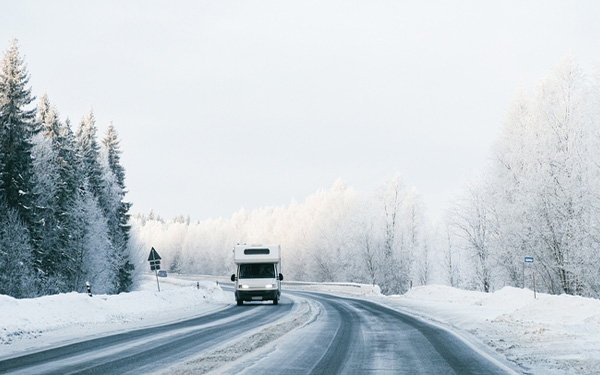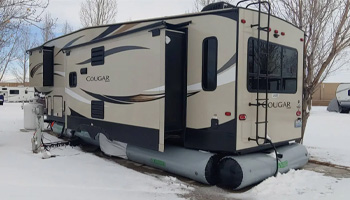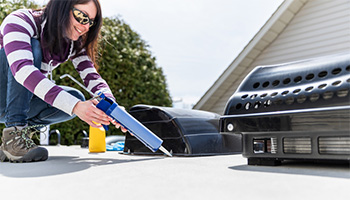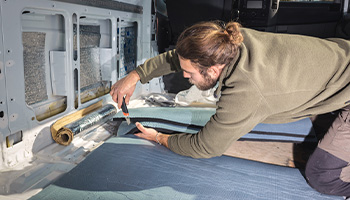How to Insulate Your RV for Winter Use

For most RVers, the adventuring season typically ends once the cold weather moves in. However, if you’re like us, you know that winter RVing can be just as fun as any other season. That said, harsh weather can be tough on your rig (and yourself) without proper planning. And if you’re traveling through snow conditions, you’ll need to do a bit more than simply purchasing a small space heater. So, if you’re looking for tips on how to insulate your RV for winter use, this guide covers some basics to get you started.
How to Insulate an RV for Winter Use
When it comes to winter RVing, preparation is key. While some campers may be classified as “all-season,” it’s still important to adequately prepare your RV for winter to avoid costly problems.
RV Insulation Tip #1: Install RV Skirting

Whether in operation or storage, below-freezing temperatures can cause your RV’s pipes to burst. To avoid a costly repair, your best bet is to invest in an RV skirt.
An RV skirt is a type of cover placed around the bottom of a motorhome or travel trailer. The material covers the gap between the bottom of the vehicle and the ground which prevents air from flowing beneath your rig, helping to keep your pipes and water tanks from freezing. RV skirts come in various materials, such as vinyl, foam boards, or canvas. If you’re looking for a skirt that doesn’t take up too much storage space, an inflatable RV airskirt may work for you.
RV Insulation Tip #2: Prepare Your Windows
While your RV’s windows are perfect for viewing the nature around you, they can also let out a lot of heat during winter. Therefore, sealing your windows should be a top priority whenever RVing in harsh weather. Give your rig a good inspection to see if any windows are showing signs of potential leaks. If so, repair them by using a window silicone caulk.
Once sealed, you can further insulate your RV by purchasing or DIYing window covers. Foam boards or foil-lined reflective insulation are inexpensive options that you can cut to fit your RV windows for added insulation. Additionally, investing in thermal pane windows may be worth it for RVers that routinely travel during winter. Thermal pane windows typically range from $250-500 per window.
RV Insulation Tip #3: Roof Vent Covers

Having vents with fans are great during summer but can let in a lot of cool air during winter. However, they are essential year-round to help reduce humidity within your rig. To prevent air from coming in, we recommend purchasing an RV roof vent cover.
RV roof vent covers are designed to allow some air out, but not in, helping to keep your RV warm. If you’ve already purchased a vent cover, performing routine inspections is important. Because they’re located on the top of your RV, it’s normal for them to wear down over time.
RV Insulation Tip #4: Add Insulation Under Your Mattress

Depending on your RV’s layout, it’s likely that there is a storage area located directly under your RV’s mattress. If so, the space may have little to no insulation, allowing cool air to flow upwards from the underside of your RV. On frigid nights, this could make your sleeping situation extremely uncomfortable.
Consider installing insulation underneath your mattress during winter to keep you warm. You can use radiant foil, foam boards, or any other thick material to properly insulate your mattress’s bottom.
RV Insulation Tip #5: Cover Your Door and Use a Door Snake
RV doors can let out a lot of precious warm air during winter months. Using a sheet of plastic and strong double-sided tape can be a quick DIY insulation hack that will keep you warm.
Additionally, a door snake can help prevent air from escaping through the bottom of your RV door. A door snake is simply an insulation-filled fabric tube that rests on your door’s bottom line, helping to insulate your RV.
RV Insulation Tip #6: Purchase a Heater
When RVing during winter, your best bet to save money will be visiting campsites with electrical hookups. That way, you’ll be able to plug in an electric heater without relying on propane or your RVs onboard heating system. However, it’s important to follow safety precautions when operating an electrical heater within an RV, such as ensuring your roof vent is working properly and that all safety alarms are functioning.
RV Insulation Tip #7: Don’t Forget Your Slide Outs
When insulating your RV, don’t forget about your slide outs if you have them. When extended, your RVs slide outs have weather-proof rubber stripping that creates a tight seal against your RV’s frame. We recommend using an RV slide out conditioner to keep the rubber stripping from tearing or damaging during harsh weather.
Protect Your RV with a Specialized RV Policy
During winter, proper insulation is crucial to staying warm in your RV. However, it’s just as important to protect your rig year-round with the appropriate RV insurance. Unlike a traditional auto policy, specialty RV insurance offers various coverages tailored explicitly for RVs. To learn more about how RV insurance works, give our RV insurance specialists a call today at (866) 501-7335.
The information in this article is obtained from various sources and is offered for educational purposes. Furthermore, it should not replace manuals or instructions provided by the manufacturer or the advice of a qualified professional. No warranty or appropriateness for a specific purpose is expressed or implied.
